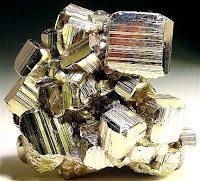


Lets start by how you may see Pyrite when looking for it. First it could be a 'cube' attached to a host rock, or a bunch of small 'crystals' in amoung other crystals such as Quartz, or maybe the real fooler, a Golden Pyrite "clump'. These are not the only way Pyrite appears however, as can be seen in several of the following pictures.
 There are several shiny brassy yellow minerals, but pyrite is by far the most common and the most often mistaken for gold. Whether it is the golden look or something else, pyrite is a favorite among rock collectors. It can have a beautiful luster and interesting crystals. It is so common in the earth's crust that it is found in almost every possible environment, hence it has a vast number of forms and varieties. During their search for forture, many infamous shouts ocurred amid the Old West propsectors "There's Gold in that Riverbed !" only to be disappointed in finding Pyrite or as the golden rock quickly became known as "fools gold". Many a gold seaker was fooled by this shiny yellow mineral that looks so similar to gold.
There are several shiny brassy yellow minerals, but pyrite is by far the most common and the most often mistaken for gold. Whether it is the golden look or something else, pyrite is a favorite among rock collectors. It can have a beautiful luster and interesting crystals. It is so common in the earth's crust that it is found in almost every possible environment, hence it has a vast number of forms and varieties. During their search for forture, many infamous shouts ocurred amid the Old West propsectors "There's Gold in that Riverbed !" only to be disappointed in finding Pyrite or as the golden rock quickly became known as "fools gold". Many a gold seaker was fooled by this shiny yellow mineral that looks so similar to gold.Pyrite is a polymorph of Marcasite, which means that it has the same chemistry, FeS2, as Marcasite; but a different structure and therefore different symmetry and crystal shapes. Pyrite is difficult to distinguish from marcasite when a lack of clear indicators exists, as can be seen by the following picture of a piece of Marcasite.
.
Almost any rock that looks a little rusty will mostly likely contain some pyrite. Pyrite is cubic crystals composed of iron sulfide; spherical and bulbous pyrites also exist; it is found in large quantities, mainly in coal mines and near clay workings. It comes in a vast number of forms and varieties, but the most common crystal shapes are cubic and octahedral.
.  ..
..
.
One sought-after form is flattened nodules found in chalk, siltstone and shale called “pyrite suns’ or ‘pyrite dollars’. These nodules are usually made from thin pyrite crystals radiating from the center.
.
Enourmous amounts of small Pyrite crystal clusters come from Oruro and Colavi, Bolivia. In Navajun (Logroño), Spain, large cubic crystals, are abundant. They are frequently embedded in a light brown matrix, and are occasionally twinned. 
.
Perfect crystals occur in Rio Marina on the island of Elba, Italy. In the U.S., there are also many fine localities. In Park City, Bingham Co., Utah, very large, well shaped Pyritohedrons and Pyrite Cubes have been found, as well as in the American Mine in the Bingham Canyon, Salt Lake Co., Utah. Large, intergrown cubes, many times partially octahedral, occur in abundance at Leadville, Lake Co., Colorado. Pyrite "Dollars" are mostly found in Sparta, Randolph Co., Illinois. The French Creek Mine in Chester Co., Pennsylvania is famous for the octahedral crystals that occur there, although most are distorted. Many interesting nodules were recently discovered in Alden, Monroe Co., New York. 
 The use of Pyrite in decorations is also quite common. How many times have you visited a mine to see mining scenes in Pyrite avaiable on the sales counters.
The use of Pyrite in decorations is also quite common. How many times have you visited a mine to see mining scenes in Pyrite avaiable on the sales counters.. And more recently, Pyrite has been faceted so that it can be made into jewelry such as rings, pendants or earrings.
And more recently, Pyrite has been faceted so that it can be made into jewelry such as rings, pendants or earrings.


